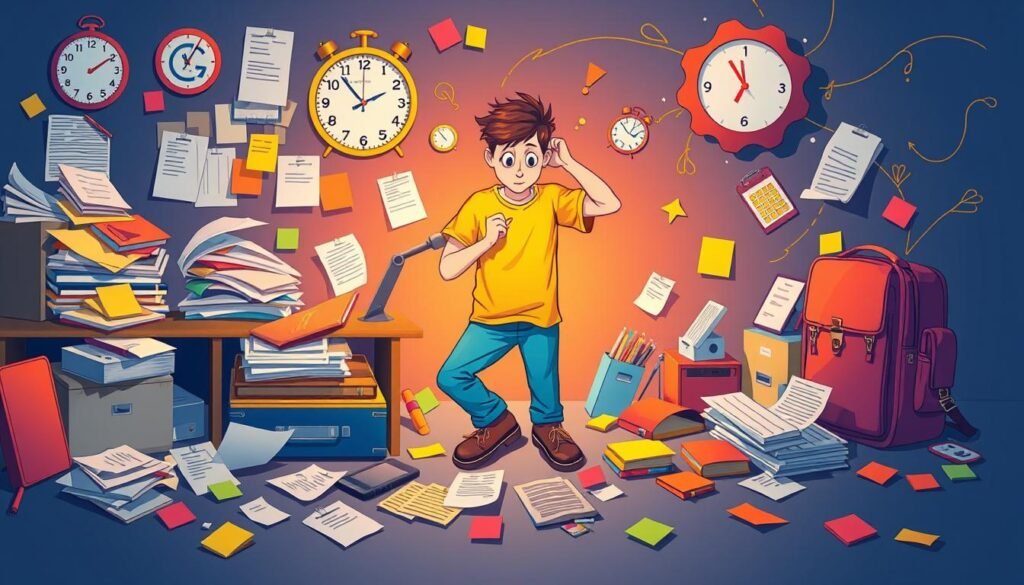30% of kids with ADHD and 53% of adults with ADHD might also have an anxiety disorder. These high numbers show how closely related ADHD and anxiety are. People often confuse the two. Knowing the key signs and differences is vital for the right diagnosis and treatment.
ADHD is marked by ongoing inattention, hyperactivity, and impulsivity. These symptoms can be similar to those of anxiety disorders, like generalized anxiety disorder (GAD). When someone has both, their symptoms can get worse. This makes daily life harder and can affect treatment. This article aims to explain these issues. It helps us understand the impact of ADHD and anxiety on a person. For more details, check out this link.
Key Takeaways
- ADHD and anxiety often occur together, making diagnosis hard.
- Up to 80% of adults with ADHD may have another psychiatric disorder.
- It’s crucial to correctly understand symptoms for the right treatment.
- Both conditions usually need a mix of treatment methods.
- Having both can make symptoms worse and affect how treatments work.
Understanding ADHD and Anxiety
Attention Deficit Hyperactivity Disorder (ADHD) and Generalized Anxiety Disorder (GAD) impact many people around the world. ADHD is known as a brain-based disorder. It shows through ongoing issues with attention, hyperactivity, and acting impulsively. About 4% of adults and 11% of kids have ADHD, highlighting its significance.
Overview of Attention Deficit Hyperactivity Disorder
ADHD is less often spotted in girls, and many don’t get diagnosed until they’re older. This condition is usually noticed in childhood. Yet, some only find out about it as adults. Nearly two-thirds of those with ADHD also have other conditions. Roughly 25% deal with generalized anxiety disorder, making everyday stresses feel worse.
Overview of Generalized Anxiety Disorder
Generalized Anxiety Disorder means worrying too much, affecting daily life. This worry usually starts young and might come with other mental health issues. People with ADHD are more likely to get anxiety disorders. In fact, up to 50% of adults with ADHD might also have an anxiety disorder. Handling both ADHD and anxiety usually requires various strategies including lifestyle adjustments, therapy, and sometimes medication.
| Condition | Overview | Prevalence | Co-occurrence |
|---|---|---|---|
| ADHD | Neurodevelopmental disorder with symptoms of inattention, hyperactivity, and impulsivity | 4% of adults, 11% of children | About 25% diagnosed with GAD |
| Generalized Anxiety Disorder | Excessive and uncontrollable worry affecting daily activities | 19% of adults, 7% of children | Higher prevalence in adults with ADHD |
Key Symptoms of ADHD
ADHD shows up in many ways, changing how one does daily things and interacts with others. Getting these symptoms right is key to correctly identifying ADHD and dealing with it well. There are two main groups of symptoms: ones about not paying attention, and ones about being too active or impulsive. Knowing these groups lets doctors create custom plans for each person.
Symptoms of the Inattentive Type
People with inattentive symptoms often find focusing and being organized hard. They might face:
- Poor organization skills that make task management hard.
- Forgetting daily activities or losing important things.
- Hard time paying attention in long tasks or talks.
- Getting easily distracted, which lowers how much they get done.
These attention-related symptoms can look a lot like signs of anxiety. To tell ADHD apart from anxiety, you can read more here.
Symptoms of the Hyperactive-Impulsive Type
The hyperactive-impulsive symptoms are about not controlling impulses and being very active. Common signs are:
- Not being able to stay still, like fidgeting or tapping.
- Cutting into conversations or jumping into activities too soon.
- Talking a lot, which might make fitting in socially tough.
- Struggling to stay seated, disturbing classroom and social situations.
Noticing these symptoms helps in spotting ADHD in both kids and adults. Studies show that about 3 in 10 kids with ADHD also face anxiety. This makes it very important to carefully check if it’s ADHD to avoid wrong labels.

Key Symptoms of Anxiety
Anxiety can show up in many ways, affecting your day-to-day life. Generalized Anxiety Disorder (GAD) is known for its ongoing, excessive worry. Knowing the symptoms of anxiety is vital. It helps you tell the difference between usual stress and signs of a disorder.
Common Symptoms of Generalized Anxiety Disorder
People with GAD often feel several symptoms. These include:
- Excessive worry: This means feeling nervous most of the time, which seems hard to stop.
- Restlessness: It’s hard to feel calm, both mentally and physically.
- Fatigue: Even simple tasks can make you feel very tired.
- Difficulty concentrating: Focusing becomes more difficult.
To better understand these symptoms, consider taking a self-assessment quiz. It can help you identify if you might have an anxiety disorder and what your triggers are.
Physical and Psychological Effects of Anxiety
Anxiety’s impact is not just in the mind but also in the body. Common experiences include:
- Muscle tension: You may feel a constant tightness or discomfort.
- Headaches: Many deal with regular tension headaches.
- Sleep disturbances: Falling or staying asleep becomes hard, worsening the problem.
Knowing these signs is crucial for recognizing when it’s more than just stress. If anxiety is harming your life quality, seeking professional help is a good step.
| Symptoms | Characteristics | Commonality |
|---|---|---|
| Excessive Worry | Pervasive thoughts about multiple life areas | High |
| Restlessness | Inability to relax mentally or physically | Moderate |
| Fatigue | Persistent exhaustion despite adequate rest | High |
| Difficulty Concentrating | Challenges in focusing on tasks | High |
| Muscle Tension | Feeling tightness or stress in muscles | Moderate |
Dealing with symptoms actively through treatment and lifestyle changes can boost well-being. Understanding the overlap between anxiety and ADHD is also critical. Visit talkiatry.com for more on managing these conditions.
ADHD vs Anxiety: Distinguishing the Differences
It’s key to know how ADHD and anxiety are different for good care. ADHD is marked by a constant struggle to focus, tied to the brain’s wiring. This means people with ADHD find it hard to concentrate even when it’s quiet.
Anxiety, however, leads to difficulty concentrating because of intense worry. When people are anxious, their minds focus more on their fears. This makes it tough to pay attention to anything else. Symptoms comparison shows that ADHD and anxiety look different up close.
ADHD also involves acting on impulse and being very active, unlike anxiety. Anxiety fills people with dread, yet doesn’t cause the restlessness seen in ADHD. These key ADHD vs anxiety differences help us see each condition clearly.
Often, women may have both conditions, making it harder to tell them apart. Many women with ADHD also deal with anxiety and depression. Their symptoms might not be as noticeable. Finding the right help to ease these symptoms is crucial for a better life.

Co-Occurrence of ADHD and Anxiety
ADHD and anxiety often occur together, creating challenges for many. Studies show that nearly half of adults with ADHD also have an anxiety disorder. In adolescents, this combination might affect more than 25%.
This makes diagnosing and treating both conditions difficult. Symptoms of one can make the other worse, leading to misdiagnosis.
Prevalence Rates and Impact
Research gives us important numbers on ADHD and anxiety. About 8% of U.S. adults have ADHD symptoms; 5.7% suffer from generalized anxiety disorder (GAD). An impressive 11% of those with GAD also have ADHD.
This overlap is significant. Having ADHD could make the risk of getting GAD go up by over 300%. It adds extra worries to those already dealing with ADHD.
How Co-Occurrence Affects Diagnosis and Treatment
Diagnosing ADHD with anxiety is complex. Shared symptoms can hide what’s really going on, causing delays in getting the right diagnosis. Experts must tell apart ADHD from different types of anxiety.
Inattention is often more tied to anxiety than hyperactivity. A personalized treatment plan is crucial. It may include both medication and therapy.
Stimulants might help with ADHD symptoms and, indirectly, anxiety. But non-stimulants and antidepressants could be better if stimulants worsen anxiety. For more details on treating both conditions together, visit this resource.

Misdiagnosis Between ADHD and Anxiety
Misdiagnosis is common when we look at ADHD and anxiety disorders. Their symptoms like not paying attention and worrying too much often mix. This makes it hard to tell them apart correctly. About one in five people in mental health care might have ADHD. Sadly, many health experts aren’t well-trained in spotting its signs, especially in women and older adults.
It’s easy to confuse ADHD with things like depression or anxiety. Many people first get diagnosed with anxiety or depression before finding out they actually have ADHD. This shows how tricky it can be to diagnose ADHD and anxiety right, especially for women and girls. They might show ADHD differently, like feeling restless instead of being super active.
Anxiety is quite common, with about 31% of adults facing it at some stage. Studies say 10 to 27% of those with anxiety also have ADHD symptoms. Surprisingly, around half of the adults with ADHD also deal with anxiety. This doubles the difficulty in diagnosing and treating both conditions. There are even stories of people getting the right ADHD diagnosis only in their 50s.
To deal with the risk of misdiagnosing, it’s vital to get a thorough checkup. Tools like quizzes can help spot particular types of anxiety. These can lead professionals to look into symptoms more accurately. To learn about different anxiety types, check out the anxiety quiz for more information.
| Condition | Prevalence | Common Misdiagnoses |
|---|---|---|
| ADHD | 2-7% of adults | Anxiety, Depression |
| Anxiety Disorders | 31% of adults | ADHD, Depression |
| Co-Occurrence | 50% of ADHD patients | N/A |
Knowing these facts can lead to better diagnosis and treatment for people with either condition. It can really improve their health and well-being.
Treatment Options for ADHD and Anxiety
Finding the right treatments for ADHD and anxiety is key. A personalized plan works best. It mixes treatments to fit someone’s symptoms and needs.
Medication for Both Conditions
Medication is crucial for controlling ADHD and anxiety. For ADHD, drugs like Adderall and Ritalin help about 70% of patients. They are safe and work well. Non-stimulant drugs, like Atomoxetine and Qelbree, help improve focus. They don’t make you feel jittery. Some people might need both ADHD and anti-anxiety medications.
- Stimulants: Adderall, Ritalin
- Non-stimulants: Strattera, Qelbree
- Anti-anxiety medications: Xanax, Ativan
- Other helpful medications: Intuniv, Kapvay (Alpha-2 agonists), Wellbutrin
It’s important to watch how stimulant medication is used. Wrong doses can make treatment fail. Sometimes, mixing ADHD and anti-anxiety meds works best.
Cognitive Behavioral Therapy and Other Therapies
Cognitive Behavioral Therapy (CBT) is great for ADHD and anxiety. It teaches people how to manage their symptoms and develop coping skills. Other therapies include EMDR, which helps with anxiety from trauma. Adding activities like exercise can also improve treatment.
- Regular physical activity to release endorphins
- Mindfulness practices to improve focus and reduce anxiety
- Dietary adjustments, such as increasing omega-3 fatty acids and decreasing caffeine
- Consistent sleep routines to enhance sleep quality
| Treatment Options | ADHD | Anxiety |
|---|---|---|
| Medication | Stimulants (Adderall, Ritalin), Non-stimulants (Strattera, Qelbree) | SSRIs (e.g., Zoloft), Anti-anxiety medications (e.g., Xanax) |
| Therapy | Cognitive Behavioral Therapy (CBT), EMDR | Cognitive Behavioral Therapy (CBT), Support Groups |
| Lifestyle Changes | Physical activity, Mindfulness techniques | Physical activity, Dietary adjustments |
Using different treatments for ADHD and anxiety can improve symptom management. Medication and therapy together can make a tailored plan. This approach enhances life quality for those affected.
Coping Strategies for Managing ADHD and Anxiety
Dealing with ADHD and anxiety involves a detailed plan. Helpful advice can make daily life better. For those struggling, blending coping strategies for ADHD and anxiety is key. Establishing a regular routine with mindfulness can ease symptoms and boost happiness.
Practical Tips for Daily Life
Managing ADHD and anxiety well often means being organized. Here’s how to do it:
- Create a Daily Routine: A set schedule makes knowing what’s next easier, lessening worry about the unknown.
- Engage in Regular Physical Activity: Working out can calm restlessness and lift your spirits. It’s a great way to fight anxiety.
- Utilize Organizational Tools: Using planners and reminders can help manage time better, which is often hard for those with ADHD.
- Prioritize Tasks: Splitting tasks into smaller parts can stop you from feeling too stressed.
Mindfulness Techniques for Reduction of Symptoms
Mindfulness is really helpful for ADHD and anxiety. These techniques help with focus and controlling emotions. Here’s what you can try:
- Breathing Exercises: Deep breathing can help keep you calm in the moment, easing anxiety right away.
- Guided Meditation: This technique centers your thoughts and can make you feel relaxed. It’s great for both issues.
- Body Scans: Mindfully checking in with your body can make you more aware of stress and feelings.
- Progressive Muscle Relaxation: Tensing and then relaxing muscles can help lessen the tension from anxiety.
Using these coping strategies for ADHD and anxiety can help build a helpful support network. By focusing on practical tips and mindfulness, you can better manage your symptoms.
| Strategy | Description | Benefits |
|---|---|---|
| Routine Establishment | Keeping a consistent schedule daily | Makes life less unpredictable, reducing worry |
| Physical Activity | Activities like walking, yoga, or team sports | Better mood and less fidgety feelings |
| Organizational Tools | Making use of planners, prompts, and apps | Helps you manage your time and tasks better |
| Mindfulness Practices | Adding in breathing exercises and meditation | Improves concentration and how you handle emotions |
Conclusion
This article has looked into ADHD vs anxiety. It showed the differences and similarities between them. It helps in getting accurate diagnoses. Many people with ADHD also have anxiety disorders. About 70% of ADHD individuals face at least one more condition, like anxiety. It’s hard to tell them apart, especially in adults. This makes getting the right treatment tough.
When it comes to ADHD and anxiety, getting help is key. Treatments often involve more than one method. This is because treating one issue might make the other worse. Options like medication and therapy, such as cognitive-behavioral therapy, work better together.
Knowing about your mental health options is important if you have ADHD and anxiety symptoms. Understanding these conditions helps. It allows people to find the right treatment, fight stigma, and push for better care. This care looks at both ADHD and anxiety closely.